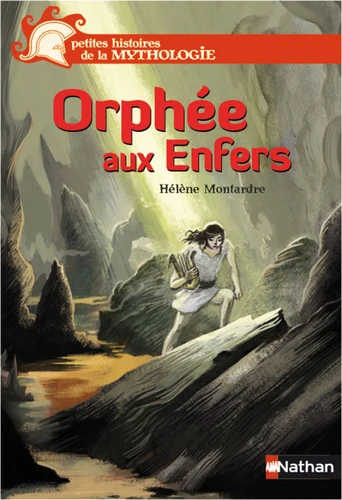Title of the work
Country of the First Edition
Country/countries of popularity
Original Language
First Edition Date
First Edition Details
Hélène Montardre, ill. Nicolas Duffaut, Orphée aux Enfers [Orpheus in Hell], Little Stories from Mythology [Petites histoires de la mythologie] 13. Paris: Nathan, 2013, 61 pp.
ISBN
Genre
Retelling of myths*
Target Audience
Children (9 years +)
Cover

Courtesy of the publisher.
Author of the Entry:
Elżbieta Olechowska, University of Warsaw, elzbieta.olechowska@gmail.com
Peer-reviewer of the Entry:
Lisa Maurice, Bar-Ilan University, lisa.maurice@biu.ac.il

Courtesy of Univers Jeunesse – Nathan – Syros – Pocket Jeunesse.
Nicolas Duffaut
, b. 1977
(Illustrator)
Born in 1977 in Aubenas, in the Ardèche region, he studied illustration at the Émile Cohl School in Lyons where he received his diploma in 2002. Since, he has been working as illustrator for a number of publishers, namely Bayard, Magnard, Flammarion, Milan jeunesse, Nathan, Sarbacane et Tourbillon. He also works for YA press. Among his illustrations connected to Antiquity are Homer’s Illiad and Odyssey:
L’Odyssée d’Homer, illustré par Nicolas Duffaut. Paris: Nathan, 2009
L’Iliade d’Homer illustré par Nicolas Duffaut, Folio Junior. Paris: Galimard Jeunesse, 2014.
Sources:
Profile at the editions-sarbacane.com (accessed: June 3, 2018);
Profile at the babelio.com (accessed: June 3, 2018);
Blog (accessed: June 3, 2018).
Interview on YouTube. Uploaded by Librairie Grangier, Illustrateur talentueux, Nicolas Duffaut nous parle de lui et de son travail (accessed: June 3, 2018).
Bio prepared by Elżbieta Olechowska, University of Warsaw, elzbieta.olechowska@gmail.com

Portrait, courtesy of Univers Jeunesse–Nathan–Syros–Pocket Jeunesse.
Hélène Montardre
, b. 1954
(Author)
Born in 1954 in Montreuil, in a family with origins in the Forez Mountains. Because of her father’s occupation (the writer Georges Montforez, 1921–1974), during her childhood and adolescence she frequently moved and lived in many different places: Saint-Étienne, Marvejols, Nantes, Loudun, Issoire. She studied English at the University of Clermont-Ferrand, where she obtained her PhD (L’image des personnages féminins dans la littérature de jeunesse française contemporaine de 1975 à 1995. Lille: Presses universitaires du Septentrion) in 1999. For the last forty years or so, she has lived with her family in the Haute-Garonne, Occitanie. During the last decade, she wrote a number of books based on a variety of Greek myths, with illustrations by Nicholas Duffaut; the books appeared in two series published by Nathan and called: Petites histoires de la mythologie and Contes et légendes jeunesse.
She has written over fifty books, mainly for children and received many literary awards:
- 1995 2nd prize for roman jeunesse du Ministère de la Jeunesse et des Sports;
- 1998 Price Livrami of the city of Pithiviers;
- 2003–2004 Price Tatoulu ;
- 2004 Price Livre, mon ami, New Caledonia;
- 2007 Price of the City of Cherbourg-Octeville, XVIIIe Livre d’Or des Jeunes Lecteurs Valenciennois, Price Ruralivres en Pas-de-Calais, Price Latulu des collégiens du Maine-et-Loire;
- 2007 and 2008 Price of Readers’ Spring, Narbonne, 2007–2008 Literary price of the Montagnes d’Auvergne;
- 2008 Price Jasmin, Agen, Price Trégor ados, Price Livrentête Culture et Bibliothèques Pour Tous, category Junior Novel.
Chronological bibliography of Hélène Montardre’s books related to classical antiquity
Non-fiction
- Hélène Montardre. L’Empire romain, Les Essentiels Junior. Toulouse: Milan, 2004.
- Hélène Montardre. La Grèce ancienne, Les Encyclopes. Toulouse: Milan, 2004.
- Hélène Montardre. La mythologie grecque, Les Encyclopes. Toulouse: Milan, 2008.
Series Petites histoires de la mythologie
- Hélène Montardre, Nicolas Duffaut, ill. Dans le ventre du cheval de Troie. Paris: Nathan, 2010.
- Hélène Montardre, Nicolas Duffaut, ill. Orphée aus Enfers, Paris: Nathan, 2013.
- Hélène Montardre, Nicolas Duffaut, ill. Les douze travaux d’Hercule. Paris: Nathan, 2011.
- Hélène Montardre, Nicolas Duffaut, ill. Zeus le roi des dieux. Paris: Nathan, 2013.
- Hélène Montardre, Nicolas Duffaut, ill. Héphaïstos et l'amour d'Aphrodite. Paris: Nathan, 2013.
- Hélène Montardre, Nicolas Duffaut, ill. Thésée contre le Minotaure. Paris :Nathan, 2013.
Series Contes et légendes jeunesse
- Hélène Montardre, Nicolas Duffaut, ill. Persée et la Gorgone. Paris: Nathan, 2010.
- Hélène Montardre, Nicolas Duffaut, ill. Jason et la Toison d'or. Paris: Nathan, 2011.
- Hélène Montardre, Nicolas Duffaut, ill. Le labyrinthe de Dédale. Paris: Nathan, 2011.
- Hélène Montardre, Nicolas Duffaut, ill. Ulysse et le Cyclope. Paris: Nathan, 2011.
- Hélène Montardre, Nicolas Duffaut, ill. L'enlèvement de Perséphone. Paris: Nathan, 2012.
- Hélène Montardre, Nicolas Duffaut, ill. Achille le guerrier. Paris: Nathan, 2012.
- Hélène Montardre, Nicolas Duffaut, ill. Pégase, l'indomptable. Paris: Nathan, 2012.
- Hélène Montardre, Nicolas Duffaut, ill. Prométhée, le voleur de feu. Paris: Nathan, 2012.
- Hélène Montardre, Nicolas Duffaut, ill. Apollon, le dieu dauphin. Paris: Nathan, 2015.
- Hélène Montardre, Nicolas Duffaut, ill. Les monstres de l'Odyssée. Paris: Nathan, 2016.
- Hélène Montardre, Nicolas Duffaut, ill. Hermès Le dieu aux mille dons. Paris: Nathan, 2017.
Source:
Website of the Maison des écrivains et de la littérature (accessed: June 26, 2018).
Bio prepared by Elżbieta Olechowska, University of Warsaw, elzbieta.olechowska@gmail.com
Summary
Calliope, one of the nine Muses, sings to her baby boy Orpheus who seems to delight in her voice. He grows up to be a child interested in music and indifferent to usual boyish pursuits causing his father to worry. Apollo offers the boy a magic lyre that is supposed to grow with him. Young Orpheus becomes an exceptional musician who plays the lyre, mesmerizing his audiences. When Jason announces his plans to travel to Colchis looking for the Golden Fleece, Orpheus volunteers, to his father astonishment.
Before he reaches Jason, the fame of his music grows. Jason invites him to join his Argonauts, and when Orpheus plays his lyre, the sea becomes gentle, winds guide Argo where it should go, and the crew works in harmony. When the Argonauts take the Golden Fleece, Orpheus travels to his native Thrace. One evening, he observes beautiful girls who dance in a clearing. He starts playing the lyre, and the girls dance the whole night. In the morning, with one exception, they leave; the most beautiful girl, Eurydice, stays to talk to him. She tells him that they are nymphs of the oak tree. Orpheus plays for them during many evenings, and whenever they leave, Eurydice stays a little longer. Finally, they get married on the river’s shore and the oaks of the forest dance at the wedding. The couple settles in the regions of Thrace inhabited by the Ciconians. Eurydice’s beauty attracts unwelcome attention. She is forced to flee an aggressive man, Aristaeus, and steps on a viper whose poison kills her. Orpheus is crazed by grief but remembers that Apollo, when he gave him the lyre, told him that it would take him to a kingdom where no mortal goes. He realizes that Apollo was talking of the Underworld. He takes his lyre and descends to the Underworld. His music charms Charon and Cerberus, and finally, also Hades and Persephone who allow him to take Eurydice back among the living under one condition: she will walk behind him, but he cannot try to turn his head to look at her, if he does, she will remain in the Underworld forever. Orpheus, worried that Eurydice will be lost in the mist, looks back, and she instantly disappears. Devastated and distraught, Orpheus tries again to convince Charon to take him across the river Styx. He plays and sings for many days and nights but is not granted another chance. Finally, he returns to Thrace and lives there in isolation avoiding all human contact. This attitude offends the Maenads, who assault him and tear him to pieces. When his lyre continues playing on its own, they throw it after Orpheus’ head into the river. The river brings both the head and the instrument to a beach where a snake approaches and is at the point of striking when Apollo appears and turns the serpent into stone. He also punishes the Maenads, who are transformed into trees and cannot move. The lyre is brought to the sky, as the constellation Lyre – one of the 48 constellations listed by Claudius Ptolemy in 2nd c. A.D.
The shade of Orpheus quickly descends to the Underworld, pays Charon with many coins and finally reunites with his beloved Eurydice.
At the end, there is, as usual for the series, a Pour en savoir plus section with basic information about characters and sources.
Analysis
The tragic episode of Eurydice’ death, the heart-rending failed attempt to bring her back to the world of the living, and the horrific death of the great musician himself are presented in a way that is more acceptable to children through a repeated emphasis on the enchanting and optimistic aspects of the story. Orpheus, playing on the instrument given to him by Apollo, can tame animals, calm the ocean, and call up favourable winds. When he sails with Jason and the Argonauts to Colchis, he ensures a harmonious voyage through his music. His wooing of the oak nymph Eurydice also resembles a scene in Paradise. Their love flourishes to the sounds of his lyre, unfortunately, there is no Paradise without a serpent, and Eurydice is attacked and then mortally bitten by a viper. Orpheus’ love and longing bring him to the Underworld, where everybody is charmed by his art, and when a happy end is near, everything falls apart, and Orpheus’ despair knows no bounds and is only stopped by raving Maenads, who kill him. This horrible event is presented optimistically as a final reunification with his beloved Eurydice. True love (and true art) conquer all. Apollo punishes the demented Maenads so they cannot harm anybody else, and the magic lyre becomes a constellation in the sky. Without major changes in the plot, the Greek myth becomes almost a Biblical parable, as far from a horror story, as possible.
Contrary to the tendency to sanitize aspects deemed inappropriate for children, such as the assault on Eurydice or the horrible death inflicted by the Maenads – as Enid Blyton does for instance, in her 1930 Tales of Ancient Greece – Montardre avoids such modifications, preferring to stress the uplifting and optimistic approach to myths.
If the reader is interested in the characters and the sources of the myth, the final section of the book provides this information.
Further Reading
Blyton, Enid, Tales of Ancient Greece, ill. Chris Price, 1st ed. 1930. Shaftesbury, Dorset: Element Children’s Books, 1998.
Haslem, Wendy, Angela Ndalianis and Chris Mackie, eds., Super / Heroes. From Hercules to Superman, Washington, DC: New Academia Publishing, 2007.
Lowe, Dunstan and Kim Shahabudin, eds., Classics for All: Reworking Antiquity in Mass Culture, Newcastle-upon-Tyne: Cambridge Scholars Publishing, 2009.
Prince, Nathalie and Sylvie Servoise, eds., Les personnages mythiques dans la littérature de jeunesse, Rennes: Presses Universitaires de Rennes, 2015.


